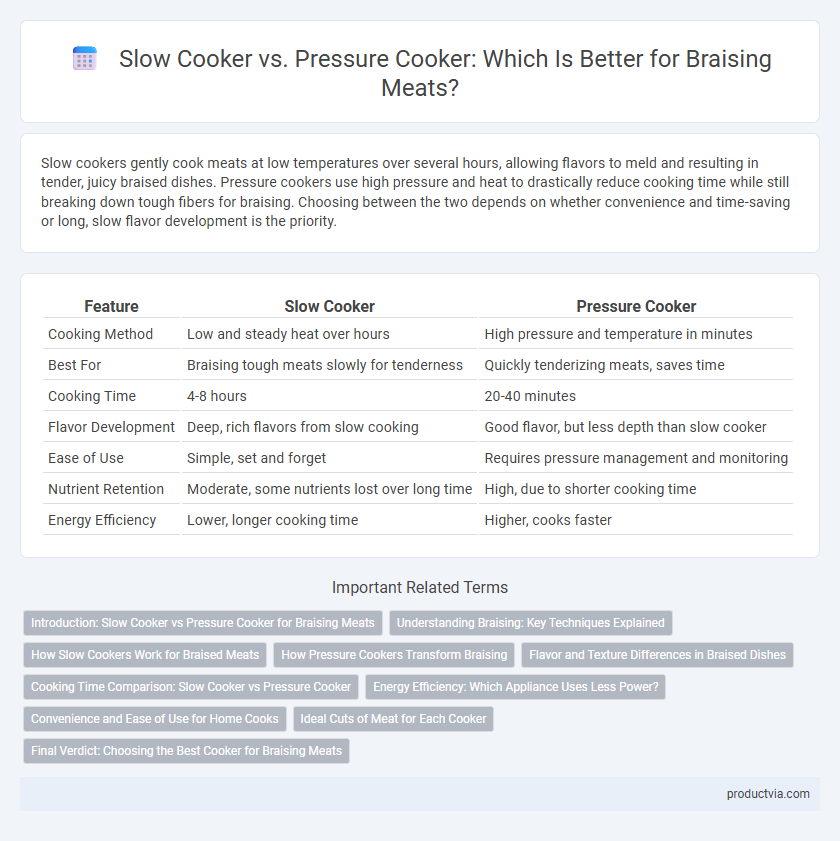Slow cookers gently cook meats at low temperatures over several hours, allowing flavors to meld and resulting in tender, juicy braised dishes. Pressure cookers use high pressure and heat to drastically reduce cooking time while still breaking down tough fibers for braising. Choosing between the two depends on whether convenience and time-saving or long, slow flavor development is the priority.
Table of Comparison
| Feature | Slow Cooker | Pressure Cooker |
|---|---|---|
| Cooking Method | Low and steady heat over hours | High pressure and temperature in minutes |
| Best For | Braising tough meats slowly for tenderness | Quickly tenderizing meats, saves time |
| Cooking Time | 4-8 hours | 20-40 minutes |
| Flavor Development | Deep, rich flavors from slow cooking | Good flavor, but less depth than slow cooker |
| Ease of Use | Simple, set and forget | Requires pressure management and monitoring |
| Nutrient Retention | Moderate, some nutrients lost over long time | High, due to shorter cooking time |
| Energy Efficiency | Lower, longer cooking time | Higher, cooks faster |
Introduction: Slow Cooker vs Pressure Cooker for Braising Meats
Slow cookers use low, steady heat over several hours to break down tough meat fibers, resulting in tender, flavorful dishes with minimal effort. Pressure cookers braise meats by trapping steam and increasing pressure, significantly reducing cooking time while maintaining moisture and enhancing taste. Choosing between the two depends on preferred cooking speed and texture, as slow cookers excel in slow, hands-off cooking, while pressure cookers offer rapid results with similar tenderness.
Understanding Braising: Key Techniques Explained
Braising meats in a slow cooker offers gentle, consistent low heat that breaks down collagen over several hours, resulting in tender, flavorful dishes. Pressure cookers use high heat and steam pressure to dramatically reduce cooking time while still tenderizing tough cuts effectively. Understanding these key techniques helps choose the optimal method: slow cookers emphasize long, slow cooking for deep flavor development, while pressure cookers prioritize speed without sacrificing texture.
How Slow Cookers Work for Braised Meats
Slow cookers use low, consistent heat over several hours to break down tough meat fibers and collagen, resulting in tender, flavorful braised meats. The sealed environment traps moisture, allowing the meat to cook in its own juices and preventing dryness. This gentle cooking method ensures even heat distribution, ideal for achieving rich, succulent braised dishes.
How Pressure Cookers Transform Braising
Pressure cookers significantly reduce braising time by using high-pressure steam to tenderize meats quickly while retaining moisture and flavor. Unlike slow cookers that require hours of low heat, pressure cookers can break down tough connective tissues in less than an hour, resulting in tender, juicy dishes. This rapid cooking method enhances the infusion of marinades and spices, making pressure cookers ideal for efficient and flavorful braising.
Flavor and Texture Differences in Braised Dishes
Slow cookers produce tender meat with a consistent, melt-in-the-mouth texture by gently cooking over several hours, allowing flavors to slowly meld and deepen. Pressure cookers braise meats faster by using high pressure and steam, which can intensify flavors but may result in a slightly firmer texture compared to slow cookers. Both methods enhance the richness of braised dishes, but slow cooking excels at creating a delicate, succulent bite while pressure cooking is ideal for speed without sacrificing flavor.
Cooking Time Comparison: Slow Cooker vs Pressure Cooker
Slow cookers braise meats over extended periods, typically 6 to 10 hours on low or 3 to 5 hours on high, allowing flavors to develop deeply and meats to become tender. Pressure cookers reduce braising time dramatically, often achieving similar tender results in 30 to 45 minutes by cooking under high pressure at elevated temperatures. For time-sensitive recipes, pressure cookers offer efficiency without compromising texture, while slow cookers provide a set-it-and-forget-it convenience ideal for long, unattended cooking cycles.
Energy Efficiency: Which Appliance Uses Less Power?
Slow cookers use low, consistent heat over extended periods, consuming around 70-150 watts, which translates to less energy usage compared to pressure cookers that operate at higher wattage, typically between 700-1200 watts for shorter durations. Despite pressure cookers cooking faster, slow cookers' low wattage results in overall lower electricity consumption during long braising processes. Energy-efficient models of slow cookers can further reduce power use by maintaining optimal temperatures without constant heating cycles.
Convenience and Ease of Use for Home Cooks
Slow cookers offer unparalleled convenience for braising meats due to their simple set-and-forget operation, requiring minimal monitoring and temperature adjustments. Pressure cookers, while faster, demand more attention and precise timing to avoid overcooking or toughening the meat. For home cooks prioritizing ease of use and hands-off cooking, slow cookers provide a more forgiving and straightforward approach to tender, flavorful braised dishes.
Ideal Cuts of Meat for Each Cooker
Slow cookers excel with tougher cuts like chuck roast, brisket, and pork shoulder, which benefit from long, gentle cooking to become tender and flavorful. Pressure cookers are ideal for similar cuts but also handle leaner meats such as beef round and chicken breasts more efficiently by reducing cooking time while maintaining moisture. Selecting the right cooker depends on the desired texture and cooking speed, with slow cookers enhancing collagen breakdown and pressure cookers accelerating the braising process.
Final Verdict: Choosing the Best Cooker for Braising Meats
Slow cookers offer gentle, consistent low heat ideal for tenderizing tough meat fibers over several hours, preserving juices and enhancing flavor depth. Pressure cookers drastically reduce cooking time by using high-pressure steam, effectively breaking down collagen in meat for quick, tender results. Choosing the best cooker depends on your time constraints and texture preference: slow cookers excel in rich, melt-in-mouth braising, while pressure cookers are perfect for fast, flavorful meals without long wait times.
Slow cooker vs Pressure cooker for braising meats Infographic

 productvia.com
productvia.com